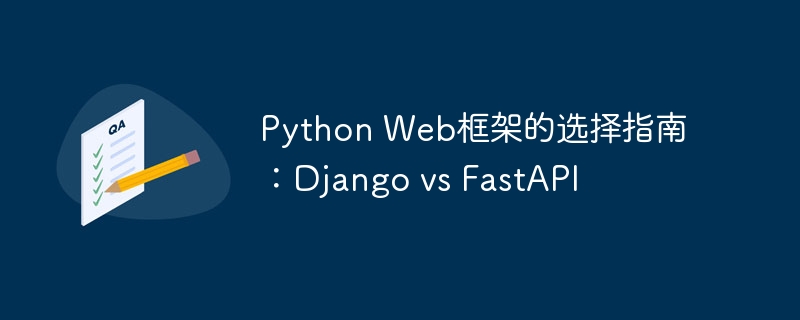Home >Backend Development >Python Tutorial >A guide to choosing a Python web framework: Django vs FastAPI
A guide to choosing a Python web framework: Django vs FastAPI
- WBOYWBOYWBOYWBOYWBOYWBOYWBOYWBOYWBOYWBOYWBOYWBOYWBOriginal
- 2023-09-27 15:09:07954browse

Python Web Framework Selection Guide: Django vs FastAPI
Introduction:
Python is a popular programming language that is widely used in web development. There are many web frameworks to choose from, two of the most popular are Django and FastAPI. In this article, we will discuss the features, advantages, and disadvantages of both frameworks and provide some concrete code examples to help you choose the right framework for your project.
- Django:
Django is a full-featured web framework that has been around for many years and is used by many large companies and organizations. It has powerful ORM (Object Relational Mapping) tools and automated Admin interface. Here are some of the main features of Django:
- Complete documentation and community support: Django has rich official documentation and a large developer community, and you can easily find various tutorials, Documentation and help.
- Automated Admin interface: Django provides a convenient and easy-to-use Admin interface through which you can manage and operate data in the database without writing any additional code.
- Powerful ORM: Django's ORM (Django ORM) provides an easy way to operate the database. It maps database tables to Python objects, making database operations more elegant and readable.
The following is a sample code that uses Django to create and display a simple web page:
# 导入必要的Django库
from django.shortcuts import render
from django.http import HttpResponse
# 定义一个视图函数
def hello(request):
return HttpResponse("Hello, Django!")
# 配置URL路由
urlpatterns = [
path('hello', hello),
]- FastAPI:
FastAPI is a relatively new web framework that Committed to providing a high-performance API development experience. It leverages modern Python 3.7 syntax, uses type annotations for fast and efficient development, and has asynchronous request processing capabilities. The following are some of the main features of FastAPI:
- High performance: FastAPI is based on the Starlette framework and utilizes asynchronous request processing and performance optimization technology to make the interface process faster. It is even capable of handling thousands of requests per second and provides stable performance for high-load projects.
- Type annotation support: FastAPI uses Python's type annotation function to perform static type checking, providing better code readability and maintainability.
The following is a sample code that uses FastAPI to create and display a simple API:
# 导入必要的FastAPI库
from fastapi import FastAPI
# 实例化一个FastAPI应用
app = FastAPI()
# 定义一个API路由
@app.get("/hello")
async def hello():
return {"message": "Hello, FastAPI!"}Comparison and selection:
Django and FastAPI are both excellent Python web frameworks. Each is suitable for different scenarios and needs.
- If you need to quickly build a full-featured web application, including management backend and ORM support, Django is a better choice. It is suitable for medium to large projects and projects that require complex relational database operations.
- If you are concerned about performance and response speed, and want to use type annotations to improve the readability and maintainability of your code, FastAPI is a better choice. It is suitable for building high-performance APIs and microservices.
The most important thing is to choose the right framework based on the project needs and team experience. You can consider factors such as project size, performance needs, development speed, documentation, and community support.
Conclusion:
In this article, we introduced Django and FastAPI, two popular Python web frameworks, and provided some concrete code examples. You can choose the framework that best suits you based on your project needs and the characteristics and advantages of the framework. No matter which framework you choose, it can help you quickly build high-quality web applications. Good luck with your project!
The above is the detailed content of A guide to choosing a Python web framework: Django vs FastAPI. For more information, please follow other related articles on the PHP Chinese website!

